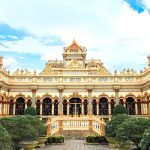Vietnam is one of the oldest tea producing nations; the Chinese introduced it while the French exploited commercial production by establishing tea plantations from 1880 in the northern regions and central highlands. Nowadays 60% of the Vietnam’s tea production is CTC tea (crush/cut, tear, curl), followed by green tea and then other varieties like Jasmin or Lotus and some uniquely special teas, like Shan Tuyet.

Vietnam is both a leading producer and consumer of tea. Recent figures list it as the world’s 6th largest tea producer yielding 217,000 metric tons, while 2013 figures calculate a consumption of 31.7 thousand tons. Being a tea drinking nation Vietnam has a tea culture, ie: in the way tea is made and drunk, the philosophy and social interaction as well as the tea ceremony. Vietnam has a less complicated, less solemn tea culture and tea ceremony tradition compared to Japan and China. While it is varied with no fixed structure, it is still sophisticated in its own right. It embodies the essence of Vietnam attaching great social importance to the preparation, serving and drinking of tea.
Traditionally, plain pure green tea (tra xanh) said to symbolize purity and beauty is preferred more than herbal and scented teas. Cao Bá Quát a 19th century poet and revolutionary, praised Vietnam’s unique tea drinking culture. The general translation reads: “Do not choose friends for their appearance, otherwise the friend essence can be mistaken. Do not drink flower scented tea, otherwise the real tea fragrance will be lost”.
In the 13th-15th centuries it was believed tea embodied philosophical values and was a source of spiritual purity. To drink tea was a refined enlightening activity.
Then in Hue during the Nguyen Dynasty, the art of tea was elevated in status. Imperial maids collected dewdrops from lotus flower leaves on Tinh Tam Lake to make tea, serving it to the kings in special teapots. Tinh Tam Lake lotus flowers were and still are considered the most aromatic and most important to the lotus tea connoisseur. Tea was enjoyed during the spring, summer, autumn and winter – a teapot for each season; the nobles would enjoy tea in romantic places, near mountains, lakes, rivers and so no. In the Nguyen Dynasty teapots and cups had weighted-down round bottoms that would wobble slightly. This was symbolic of Vietnam surviving many ups and downs.
The art of traditional Vietnamese tea drinking is based on its preparation, the invitation and the enjoyment in the process. Important steps include: the water source, the tea variety, the correct form of tea preparation, the type of cups and teapots used (which must match the tea depending on the season) and finally the social aspect of drinking, whether solo or in a group.

Skilled tea artisans boil the water pouring it into the teapot containing dried tea leaves. After it has steeped the tea is poured slowly and gracefully into cups by a process called ‘high mountain long river’ ensuring the scent and temperature are evenly distributed. The tea host then offers each guest their cup, holding it with three fingers which symbolizes ‘three dragons flanking a pearl’. The ensuing conversation should focus on the tea, its taste, the feeling … always talking of the present. Never the past or future.
While plain green tea is the most common to drink, basic green tea scented with flowers is also valued in Vietnamese tea culture. This is prepared by hand to ensure the natural scent is transmitted to the tea. Two such varieties include Jasmin tea (tra nhai) and Lotus tea (tra sen). With the latter plain tea leaves are placed in opened lotus flowers at midnight, the petals are tied together sealing the tea and perfume and then handpicked before dawn. As Nguyen Tuan a 20th century writer points out, Lotus tea is a very precious tea that “reflects the precision, style, elegance and connoisseurship of Hanoian culture, and Sen Tea is the most precious and popular perfumed tea”.
The elderly are said to worry that today’s young generation are losing the tea drinking culture. In actual fact the culture remains strong and much loved by all generations. Whether in tea cafes (traditional, avant-garde or modern); from the tea vendors on street corners, bus stops, rail and bus stations where people congregate selling hot tea (tra nong) or iced tea (tra da); quintessential lemon tea cafes (tra chanh) or just at home with the family. Tea has always been and will always be served in meetings, weddings, funerals, anniversaries, festivals, rituals and so on. It is drunk any time, any day, anywhere, by anyone and Vietnam’s tea culture continues to be a social activity that unites all ages.
Source: ehgnews.com






